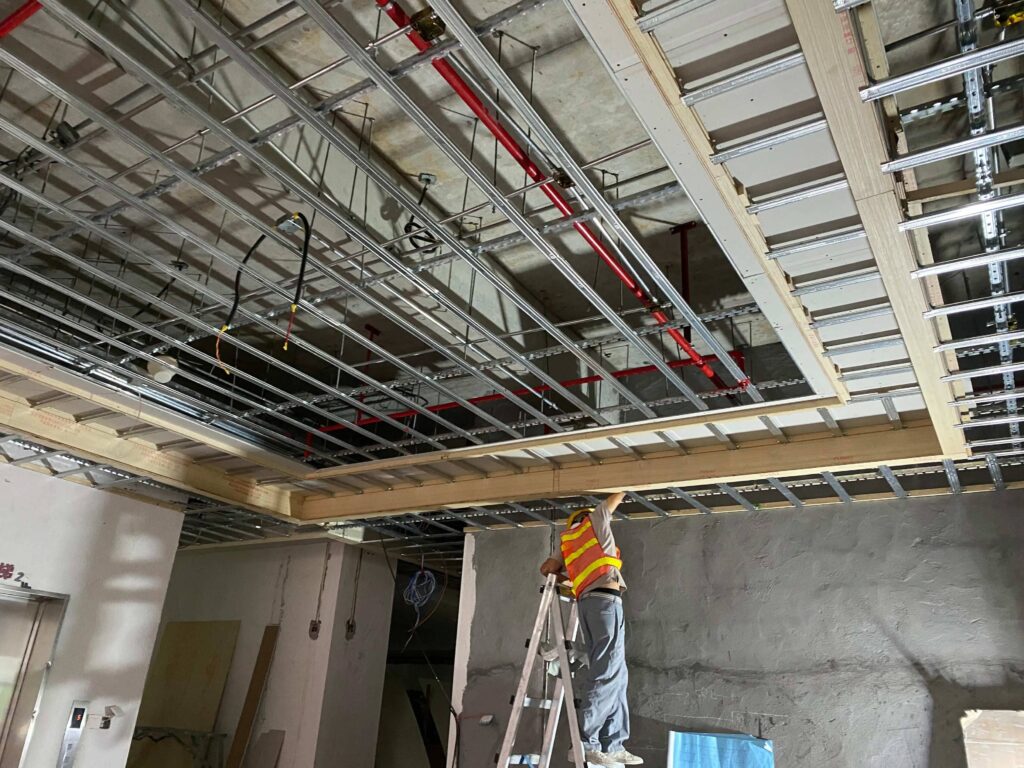
Ceilings serve as integral parts of home decor, with visually appealing designs amplifying their meaning.
China’s contemporary homeowners favor lightweight steel profiles for ceiling enhancement. An aesthetically pleasing yet robust ceiling is achieved through straightforward processes.
We begin installation with specific attention to profile placement. This is essential for horizontal and vertical alignment. Floor height and design specifications dictate the marking of ceiling corners at the top of the wall.
Subsequently, we install hanging hooks at regular intervals of 900-1200mm, ensuring uniform spacing. Height adjustment is also critical.
The main channel is attached using a hanger clip. This is followed by the installation of ceiling carriers under the main channel, maintaining a gap of about 400-450mm.
After installation, profile connectors receive a coat of rust-resistant paint for longevity and durability.
Finally, we conclude the construction of the ceiling by installing additional materials such as gypsum boards in the predetermined shape of the ceiling.
In conclusion, our meticulous installation process ensures seamless integration of steel profiles into your sloped ceilings.
Suspended ceiling construction involves critical aspects. We explore vital considerations for optimal performance and longevity.
Industrial flooring requires precision and diligence. Here’s a guide to installing a skilled and safe profile.
First, ensure your profile is safe and fireproof during installation for long-term use in high-traffic areas.
Second, control drill bit forces to prevent floor damage.
Third, verify adequate rust resistance before panel placement for durability.
Fourth, select reliable materials that adhere to industry building standards during panel installation.
In addition, ensure that the plate adheres tightly to the profile to prevent potential cracking during installation. Include suitable expansion joints and partitions for thermal expansion and contraction management.
Finally, conduct a thorough post-completion inspection to confirm that there are no visible defects.
By following these steps, you can build a durable and aesthetically pleasing industrial floor.
Next, let’s discuss various ceiling material choices.
Optimal ceiling materials form critical components for a perfect interior design. Selection depends on specific needs. Common options include Gypsum Board, Artificial Board, Mineral Wool Acoustic Panel, and Plastic Buckle Board.
Gypsum Board, known for its strong fire resistance, sound insulation, and heat insulation capabilities, is favored for its affordable price.
Artificial panels, on the other hand, hold remarkable qualities such as high-temperature tolerance, corrosion resistance, and water resistance, making them suitable for kitchens or bathrooms.
For quiet environments, a Mineral Wool Acoustic Panel is a suitable choice. The inherent sound absorption properties of this material significantly reduce ambient noise levels.
Finally, the Plastic Buckle Board, with its economical nature, provides exceptional waterproof, moisture-resistant, and easy-to-clean properties, making it a preferred choice for damp spaces such as kitchens and bathrooms.
In the construction of suspended ceilings, adhering to specific criteria is imperative. Essential considerations include material consistency and quality assurance for structural robustness. In addition, full compliance with industry regulations is key to the successful implementation of suspended ceiling projects.
In suspended ceiling installation, critical emphasis must be placed on construction quality, encompassing factors such as structural integrity, aesthetic value, and installation convenience.
Integrating suspended ceilings into your home requires extensive review before installation begins. Here are the key elements for optimal results:
First, the uniformity of the ceiling is paramount. Unevenness impeding seamless installation must be corrected before progress can be made.
Secondly, the focus should be on the joint integrity of the ceiling. Their accuracy is vital to prevent leaks or defective construction.
Third, the stability of the ceiling is essential because it guarantees the durability of the structure. Installing a strong ceiling is crucial for both aesthetics and structural integrity.
In addition, the fire resistance of the ceiling is crucial. Adherence to prevailing industry standards is necessary to ensure safety below the ceiling.
Finally, the moisture resistance of the ceiling is equally important. Humid environments can cause significant damage if the ceiling lacks sufficient moisture resistance.
In conclusion, the above factors form an integral part of the assessment of the suitability of a suspended ceiling. Implementing these prerequisites paves the way for a successful installation for years to come.
Adherence to these strict acceptance criteria during the suspended ceiling construction phase is critical for quality assurance and safety enhancements within your intended ceiling system.

